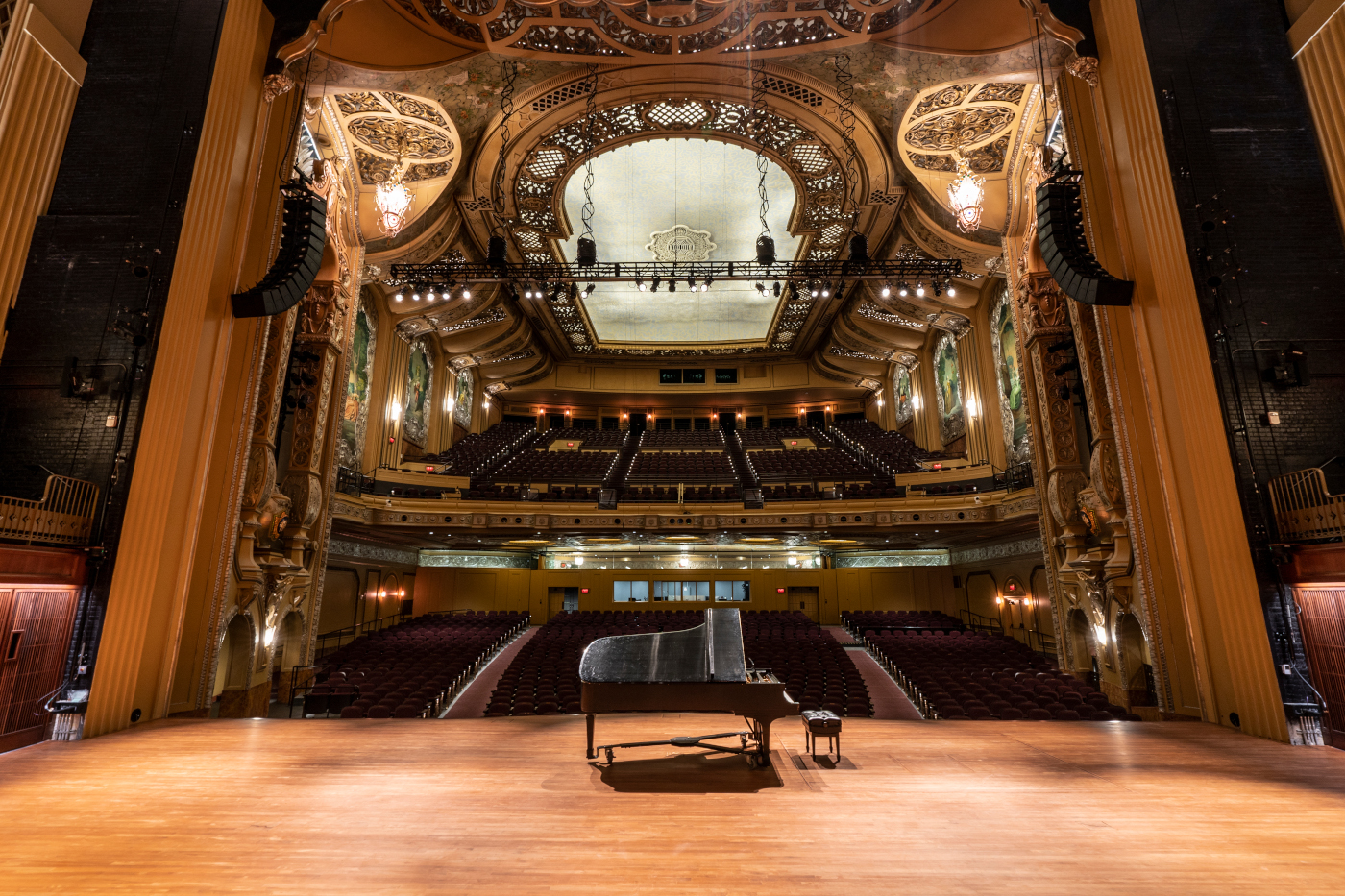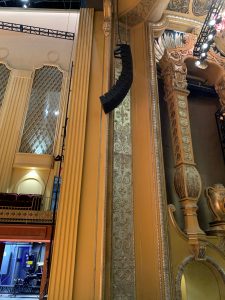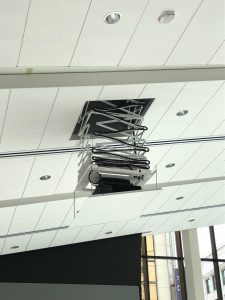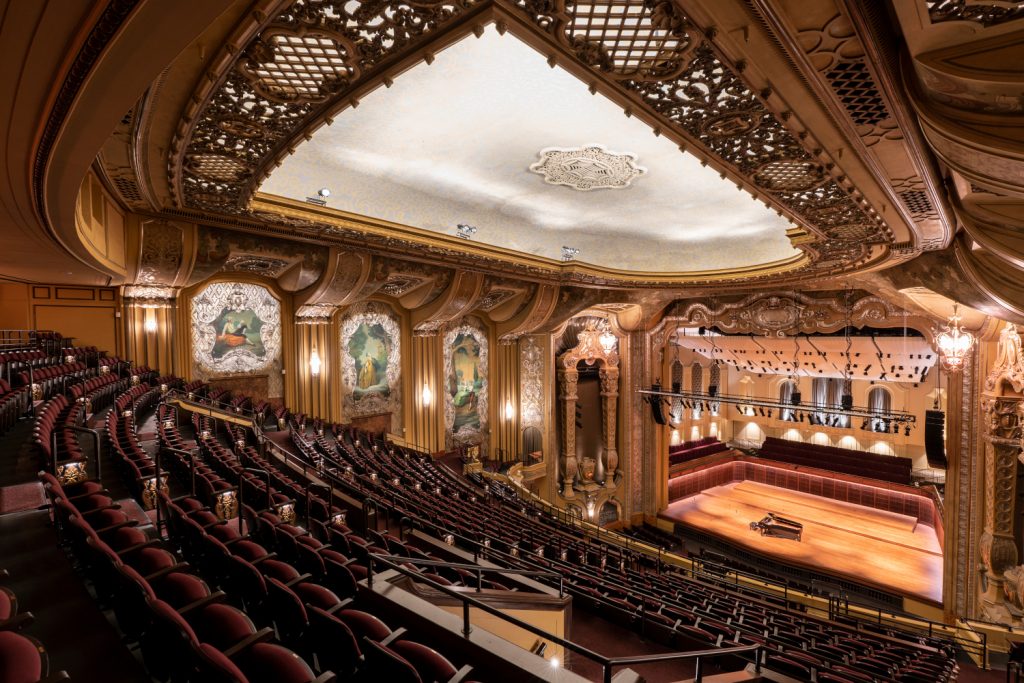Milwaukee’s Bradley Symphony Center impresses on every level.
Milwaukee WI was a tough town in the 1930s. According to the University of Wisconsin’s history of the era, between 1929 and 1933, the city’s foreclosure and eviction rates more than doubled as the Great Depression settled in over the Midwest. Barely 2,000 cases of public-assistance need were reported in 1929; however, by 1933, there were more than 34,000 families and individuals on relief. That amounted to 21 percent of the entire county population. Milwaukeeans needed something to perk up their spirits.
On May 1, 1931, they got it in the form of The Warner Theater, owned by the eponymous Hollywood film studio. It was one of the lavishly appointed cinema palaces that arose throughout the US during the 1920s and early ’30s, offering some affordable escape from the economic miseries of the Wall Street crash of 1929. Cinema Treasures describes the theater as “the fanciest” in Milwaukee and as “one of the most beautiful in the nation,” featuring vibrant murals, layers of decorative Deco details and soaring mirrored walls in the lobby. The Warner later become the Grand, whose ambitious new name belied the funk that overcame the city’s downtown (as well as other downtown areas of US urban centers in the 1970s and ’80s). It closed for good in 1990.
However, 90 years after the Warner opened, the theater has now come back to life as the 1,650-seat Bradley Symphony Center, the sumptuous new home of the Milwaukee Symphony Orchestra (MSO).

High-End Acoustics
The result of a three-year, $90 million renovation project, this hall is incredibly flexible. It’s capable of the acoustically coherent symphony performances that a symphonic orchestra requires, while also being the kind of performing-arts center that the hall’s economic minders demand, capable of accommodating touring shows and performances with its own touring-class public-address (PA) and video-projection systems.
Michael Umile, AV Systems Designer for Akustiks, AV and acoustical consultant for the project, described the Bradley Symphony Center as follows: “An acoustically, sonically high-end symphonic hall that also supports amplified performances—just enough reverb, but not too much.” He continued, “The intent was to consistently reach every seat with sound that works within the acoustical envelope that Paul Scarbrough [Akustiks’ Principal and the project’s Acoustical Designer] laid out for it.”
That acoustical design was fundamental to the hall’s restoration, but effectuating it was by no means a snap. What worked sonically for a film house wasn’t necessarily what a symphony orchestra would require. Christopher Ludwig, who served as lead designer for the Bradley Symphony Center’s architectural firm, Kahler Slater, told the local public-radio station that they wanted to assure themselves and the orchestra that the space would be a good fit. So, they removed the first seven rows of seats to do acoustical testing. “They expanded the stage and they brought the orchestra in and they did some tests to see if the hall provided the right acoustic characteristics that they were looking for. So, that was pivotal,” he was quoted as having said. Part of that initial planning also included a directive to move the theater’s 625-ton upstage wall back about 35 feet so as better to accommodate the larger stage that the symphony would require.
Those initial tests actually took place two decades ago—before Akustiks entered the picture—but they were important to the present-day project. “The success of that exercise fired people’s imaginations for what the theater might become,” Scarbrough explained. “The original stage was only about 15 feet deep—nowhere near large enough for a full symphony orchestra. While removing some seats and extending the stage worked to give the acoustics a test run back in 2000, it was not possible for the stage to be permanently extended that far into the auditorium [because] the sightlines from the balcony were drawn to the edge of the original stage. Moving out into the auditorium would mean that many people in the balcony would not see the downstage performers, including the conductor, first violins and cellos. This meant that expanding the stage upstage into N. 2nd St. was essential to creating a properly sized orchestral stage.”
Although this significant architectural and structural change was rooted in sightline issues, expanding the stage was critical to the acoustical planning, as well. “One key element of that involved raising the top of the proscenium arch to allow the stage and audience chamber to function more like a single volume acoustically,” Scarbrough explained. “The expansion also allowed us to create an elevated choral terrace above and behind the orchestra. This increased the total performance area and allowed us to separate the traffic flows for the orchestra and chorus, making movement backstage much more convenient….”
Scarbrough continued, “And, of course, when the program does not feature a choral work, the choral terrace is available to the public, giving audiences a unique visual and sonic perspective on the orchestra. But the stage expansion also adds a significant amount of cubic volume to the hall, lending greater reverberance to the space than it originally possessed. Finally, the stage expansion offered us the opportunity to integrate the full panoply of contemporary acoustic and audiovisual technologies into the space, including a fully adjustable acoustical canopy, video-projection screen, sound-reinforcement systems and adjustable acoustic-drapery systems. There is even space reserved for a potential future pipe organ above the choral terrace.”

Getting The Picture
Akustiks’ brief went well beyond the Bradley Symphony Center’s acoustics. It also included its AV-systems specifications, which would be installed by AV integrator Professional Audio Designs (PAD), and how those elements integrated into the acoustical designs, landmarked aesthetics and noise isolation. A case in point is the Christie D13HD projector that is mounted on the scrimshawed face of the balcony, part of the building’s historic trim. The projector’s location was dictated by the size and thrust of the balcony itself; it had to be in front of the seating, instead of behind and over it, in order fully to illuminate the 227-inch (diagonal) Draper Paragon V TecVision drop-down screen onstage. However, placing the projector out in the open would create the potential for fan noise that could intrude during pianissimo musical passages and other critical quiet moments. (The projector is used, for instance, when the MSO provides a live score for silent or contemporary films.)
The solution was to enclose the projector, along with a Panasonic AW-HE40SK pan-tilt-zoom (PTZ) camera and pair of Marshall CV350 cameras, in a padded box that fits into the lighting cove that runs the length of the balcony face. The stage managers use the cameras to oversee the stage action and to send a static feed of the stage to displays in the offstage wings, back-of-house spaces, lobby and other common areas. This allows, for example, patrons who are on a break to stay apprised of what’s taking place in the hall.
“It was more complicated that it might seem,” Umile remarked. “We had to work with the architect to make sure that the enclosure matched the design on the balcony, which they had recreated using the original blueprints. And we had to coordinate with PAD, who ran the fiber and category cabling to the projector and cameras, and [we] had to make sure the enclosure could bring in fresh air and exhaust the hot air so the projector didn’t overheat.”
Additional infrastructure is provided from the balcony seating for dual-stack projectors for larger shows, along with infrastructure on the choral terrace for rear-projection scenarios. This enables the MSO’s technical staff to project from multiple locations in the hall. Another projector is mounted on a drop-down lift in the venue’s multipurpose room; that one, too, is paired with a Draper screen. That space presented its own challenge—namely, an upward-sloping ceiling and undulating ceiling panels that, according to Umile, make for a “cool visual effect, but [are] a pain to mount the projector through.” The team resolved that issue by having the lift plate configured to match the ceiling’s design.
“The ceiling panels articulate down the length of the multipurpose room in a wave-like fashion,” Umile elaborated. “So, Draper and PAD worked together to mount the SLX projector lift’s closure panel on a very specific 10.47-degree angle in order to match the ceiling. The result is an excellent alignment that makes the projector enclosure disappear when retracted.”

Networked Elements
Infrastructure ties together the Bradley Symphony Center’s main performance hall and its ancillary spaces, including the multipurpose room, a Founder’s lounge, green room, and pre-performance spaces for musicians and other performers. Audio uses Dante and multichannel audio digital interface (MADI) as network formats, whereas video moves over a Crestron NVX IP network, with a Dante interface for the NVX providing synchronized AV streaming. All that is on a 10Gb network, which is in fact running at 1Gb, with the headroom built in to ensure the setup was futureproofed.
“Each space is a node on the networks and can share all of the AV signals, but each space also is its own independent AV system, with Crestron wall panels for control in the lounges, dressing rooms and the lobby,” Umile said.
However, Umile added, networked AV has a few “gotchas” of which designers, installers and users have to be aware. ”If you push updates to some devices on the network or change configurations, other devices may lose connectivity, and you’ll have to reboot them individually,” he explained. “You also need to make sure that all of the switches are properly talking to each other when they’re dealing with proprietary formats like Dante and communicating with multiple manufacturers, all of which have their own network-configuration requirements. It requires a good network engineer, which, fortunately, PAD provided.”
Sound Ideas

In the performance hall, things are just as complicated when it comes to audio. There, a d&b audiotechnik Vi8 system was installed in two hangs of 12 boxes each, along with Vi subs. Plus, there are five E6 speakers arrayed as front fills across the lip of the stage, as well as a DiGiCo SD12 console that sits at front of house (FOH). Those are all connected via multimode fiber. “We didn’t even consider category cable for this because we knew we’d [quickly] hit the distance limitations on that,” Umile remarked. A number of formats and processes, including sample-rate conversions, are necessary for the integrated system to work. For instance, the DiGiCo console natively runs at 96kHz and interfaces with the recording equipment via AES at 96kHz, as well. “We maintain AES to feed the d&b amplifiers for the mains,” Umile said. “The system also down-samples to 48kHz in a DiGiCo Orange Box for interface with the two QSC Core processors used for distribution throughout the facility.”
Although it’s preferable to avoid this kind of audio-format complexity when possible, Craig Basten, Project Manager for PAD, confirmed that it was necessary here because running DiGiCo’s native MADI format at 96kHz was necessary to communicate between the console and multiple stage boxes on the Optocore ring. The d&b amplifiers run on AES, and Dante was employed for various audio-network access points, the hearing-loop signal and back-of-house distribution. Plus, the MSO wanted 96kHz for recording and MADI is a perfect match for that particular use case. (A recording studio located in the basement is also connected to the larger audio infrastructure, but it was largely specified and outfitted by the MSO itself. “Akustiks’ and PAD’s involvement with that pretty much stopped at the racks,” Umile stated.)
There are two FOH positions available in the room’s seating area, and a house mix can also be done from a small control room at the rear of the house. That room can also control the Panasonic PTZ cameras, six more of which were added late in the project to help support the streamed performances that will continue as long as the novel coronavirus (COVID-19) pandemic remains. The room also manages the assistive-listening systems, one of which is a Listen Technologies radio-frequency (RF)-based system that beams from an antenna installed above the ceiling of the stage proscenium; the other is an Ampetronic phased-loop wired system with copper laid in the concrete below the seating floor. The inductive loop is split into four zones between the floor and balcony. This, Basten commented, permits independent, time-aligned delays.
Both Umile and Basten readily agreed that the d&b system was the best choice for the project. “The main push for d&b was the system processing [that] it offers, followed by the smaller footprint,” Umile said, noting the liveliness of the hall’s natural acoustics. “Plus, the MSO folks showed us some of their contract riders and d&b is on almost every one of them.” Basten specifically pointed to d&b’s ArrayProcessing, an optional software function within the d&b ArrayCalc simulation software, which uses an optimization algorithm to determine tailored filters to help control the behavior of a d&b line-array system across an entire listening area.
“The ArrayProcessing uses one amplifier channel per box and a combination of various [frequency] filters to precisely sculpt the coverage for extremely even coverage, both in terms of SPL [sound pressure level] and spectrum,” Basten described. “Various systems were modeled and compared early in the project, and there was simply no equivalent to what d&b could offer in this theater.”
Tristan Wallace, the MSO’s Technical Production Manager, said the choice of the SD12 console was based on experience with the DiGiCo brand and that model. “I’ve used the SD12 all over the world while on tour, and I felt like it was a good fit,” he affirmed. ”It’s versatile, it’s user friendly, it’s easily movable and it’s upgradeable.” Although the venue had not yet hosted a public performance at the time that he spoke, Wallace said that the SD12’s performance during some livestreams proved the decision was a good one.
Its flexibility was demonstrated when a visiting performer did a streamed performance and needed some stage monitors, Wallace elaborated. ”We were able to simultaneously record and run monitors from the SD-Rack via a MADI split,” he said. ”I’m also impressed with the options inside the Orange Box. We’re able to use cards for the sample-rate conversion between 96kHz on the console and 48kHz for Dante.”

History’s Mysteries
Working in historically sensitive environments like the former Warner Theater requires extra diligence, coordination and care, as well as problem-solving acumen. “You’ll go to install a flatpanel display on a wall and find out the wall is actually made of clay tile, which can’t support the display,” Basten said, citing one of a number of such surprises on the Bradley Symphony Center project. Other challenges included old infrastructure behind planned equipment locations, conduit-routing difficulties, and other unique and unpredictable factors that appear as part of a historic renovation. “And all of those situations have to be handled carefully because you can’t damage any of the original plaster or decorative work,” Basten emphasized.
Complicating things even further was the fact that the renovation was funded, in part, by $16 million in federal and state historic-preservation tax credits, which the National Parks Service (NPS) oversees. “So, we had the NPS’ governance over decisions about what could be placed where,” Basten said. “Each time something couldn’t be placed where it was originally planned to go, it had to be coordinated with the consultant and with the general contractor, as usual, but also reauthorized through the [NPS] oversight.”
Basten continued, “There was an extra tier of coordination for much of that, and we had to think on our feet to devise solutions for those instances. Great partnership and communication between Akustiks, Kahler Slater and CD Smith made these occurrences much easier to deal with.” New rigging points were added as part of the renovation, including a center rig point with installed cabling, as well as the left and right points. Polar Focus Z-Beam and spline-frame adapters were used to enable pan and tilt control of the arrays. Each array employs two chain motors.
While the Bradley Symphony Center has been awaiting its first string of live, attended performances, the people who put it together have enjoyed standing back and simply marveling at it. “Putting an A-level touring PA system into a beautiful historic building like this was a challenge, but a wonderful one,” Basten said. “We can send audio and video anywhere in the venue and you’ll never know where the cabling or other systems are. We left the building looking like it should.” Wallace added, “PAD, Akustiks—everyone did a great job on this project. The sound is fantastic, and not just in the hall. It’s great right through the QSC ceiling speakers that get the music to every square inch of the venue.”

ABRIDGED EQUIPMENT
ASSISTIVE-LISTENING SYSTEM
6 Ampetronic ACDB25200 direct burial cable for hearing loops (2.5mm2, 200m reels)
4 Listen Technologies DBC2.5-100 direct burial cables (328′)
2 Listen Technologies DBC2.5-200 direct burial cables (656′)
3 Listen Technologies LA-122 universal antenna kits (72MHz and 216MHz)
3 Listen Technologies LA-326 universal rackmounting kits
3 Listen Technologies LA-381 intelligent, 12-unit charging trays
3 Listen Technologies LA-382 intelligent cable-management units
36 Listen Technologies LA-401 universal ear speakers
36 Listen Technologies LA-405 universal stereo ear buds
62 Listen Technologies LA-430 intelligent earphone/neck-loop lanyard
51 Listen Technologies LP-IL-1b hearing-loop receivers w/lanyard packages
62 Listen Technologies LR-5200-072 advanced intelligent DSP RF receivers (72MHz)
3 Listen Technologies LT-800-072-01 stationary RF transmitters (72MHz)
CONTROL/NETWORK/PROCESSING
1 Apple MY2H2LL/A 12.9” iPad Pro (4th generation) w/Wi-Fi (128GB)
1 Crestron CP3N 3-Series control system
1 Crestron TSW-760-B-S 7” touchscreen (black, smooth)
1 LynTec SS-2LRP 1RU locking rack plate switch set
1 NETGEAR M4300-24X24F 24x10G and 24xSFP+ managed switch
2 NETGEAR M4300-52G-PoE+ 48x1G PoE+ 591W, 2x10G, 2xSFP+ managed switches
2 NETGEAR M4300-8X8F stackable managed switches w/16x10G including 8x10GBASE-T and 8xSFP+ Layer 3
5 QSC CAES4 AES-3 digital input/output cards
1 QSC CDN64 Dante audio bridge card
1 QSC CIML4 mic/line analog input card
1 QSC COL4 analog line output card
2 QSC Core 510i Q-SYS integrated core processors
2 QSC SL-QSE-110-P software licenses
2 QSC SL-QUD-510-P UCI licenses
2 Ubiquiti Networks UniFi AP AC LR 802.11ac long-range access points
EFFECTS/MONITORS/ONSTAGE
4 Anchor Audio AN-1000X+ powered speaker monitors
5 d&b audiotechnik E6 2-way compact coaxial speakers (front fills)
4 d&b audiotechnik 16C installation-specific, cardioid column speakers (monitors in stage wings)
1 d&b audiotechnik 10D installation-specific, 4-channel amp
4 d&b audiotechnik Z5442.000 wallmount columns (black)
8 EAW MicroWedge touring monitor
FOH/STAGE-MIX PROCESSING
1 DiGiCo FC-SD12 flight case for SD12-96 console
1 DiGiCo MOD-DMI-DANTE multi-channel Dante option card
1 DiGiCo MOD-DMI-OP-NC multimode Optocore I/O card on OpticalCON
11 DiGiCo MOD-SDR-ADC-32B 32bit, 8ch. mic/line input cards
7 DiGiCo MOD-SDR-BLANK blank panel
3 DiGiCo MOD-SDR-DAC-32B 32bit, 8-ch. line output cards
1 DiGiCo MOD-SDR-DANTE 8ch. Dante I/O card
1 DiGiCo Orange Box 2RU, bidirectional, multi-channel audio-format converter
1 DiGiCo SD12-96 digital mixing console
1 DiGiCo SD-Rack 14-slot input/output rack
2 DiGiCo SD-Mini 4-slot compact input/output rack
3 Gator Cases G-PROR-6U-19 6RU, 19”-deep molded audio racks w/wheels
1 OSP Cases RC6U-20 6-space ATA rack
4 Ultimate Support speaker stand (black)
10 Whirlwind custom fiberoptic multimode cables (various)
INTERCOM
10 beyerdynamic DT 108 single-ear headsets w/dynamic mics for broadcast and intercom (closed)
10 beyerdynamic K 109.28 connecting cables w/4-pin XLR female (1.5m)
1 Clear-Com MS-704 4-channel, 2RU main station w/built-in speaker
10 Clear-Com RS-701 single-channel beltpacks w/XLR-3 connectors
MAIN ARRAYS AND SUBS
2 d&b audiotechnik adapters (4x NL4 to NLT8M)
24 d&b audiotechnik Vi8 installation-specific, high performance, 3-way, passive line-array speakers
2 d&b audiotechnik Vi installation-specific, high-performance, flyable, cardioid subs
7 d&b audiotechnik 30D installation-specific, 4-channel amps
6 d&b audiotechnik adapters (NL8TF to 4x NL4)
2 d&b audiotechnik Z5380 V Flying Frames
2 Polar Focus PY1-ZBR-1550-B PY1 quick-disconnect fitting w/Zbeam w/rocker arms
2 Polar Focus SFA-16-1100 spine frame adapters
6 Whirlwind custom cables w/Neutrik NLT8MX-BAG connectors (100′, 8-conductor cables)
MULTIPURPOSE ROOM
1 Attero Tech by QSC unD6IO-BT Dante/AES67 audio interface w/Bluetooth
1 Crestron TSW-760-W-S 7″ touchscreen (white, smooth)
4 d&b audiotechnik 24C installation-specific, cardioid column speakers (local sound reinforcement)
1 d&b audiotechnik 10D installation-specific, 4-channel amp
4 d&b audiotechnik Z5442 wallmount columns
1 NETGEAR M4300-8X8F stackable managed switch w/16x10G including 8x10GBASE-T and 8xSFP+ Layer 3
1 QSC Core 110f Q-SYS unified core
VIDEO PRODUCTION/VIDEO PROJECTION
1 Blackmagic Design ATEM 1 M/E Production Studio 4K
1 Blackmagic Design CONVNTRM/YA/RSH Teranex Mini rackshelf
1 Blackmagic Design DeckLink 8K Pro cinema capture card
3 Blackmagic Design HyperDeck Studio Mini miniaturized broadcast decks
2 Blackmagic Design Mini Converter SDI to HDMI 6Gs
1 Blackmagic Design MultiView 16 multi viewer
1 Blackmagic Design Smart Videohub 20×20 advanced 20×20 multi-format SD, HD and ultra-HD SDI router
1 Christie 1DLP, solid-state, HD 1920×1080, 13,000-lumen, 93.7lb. projector (black)
1 Christie 4.0-7.0:1/5.66-10.18:1 zoom lens
1 Crestron DM-NVX-351 DM NVX 4K60 4:4:4 HDR network AV encoder/decoder w/downmixing
1 Crestron SFP-1G-SX SFP transceiver module for DM-NVX Series (duplex multimode fiber, 850nm)
3 LG 32UN650-W 32” UltraFine ultra-HD IPS HDR monitors w/FreeSync
List is abridged and edited from information supplied by project participants.
To read more from Sound & Communications, click here.
